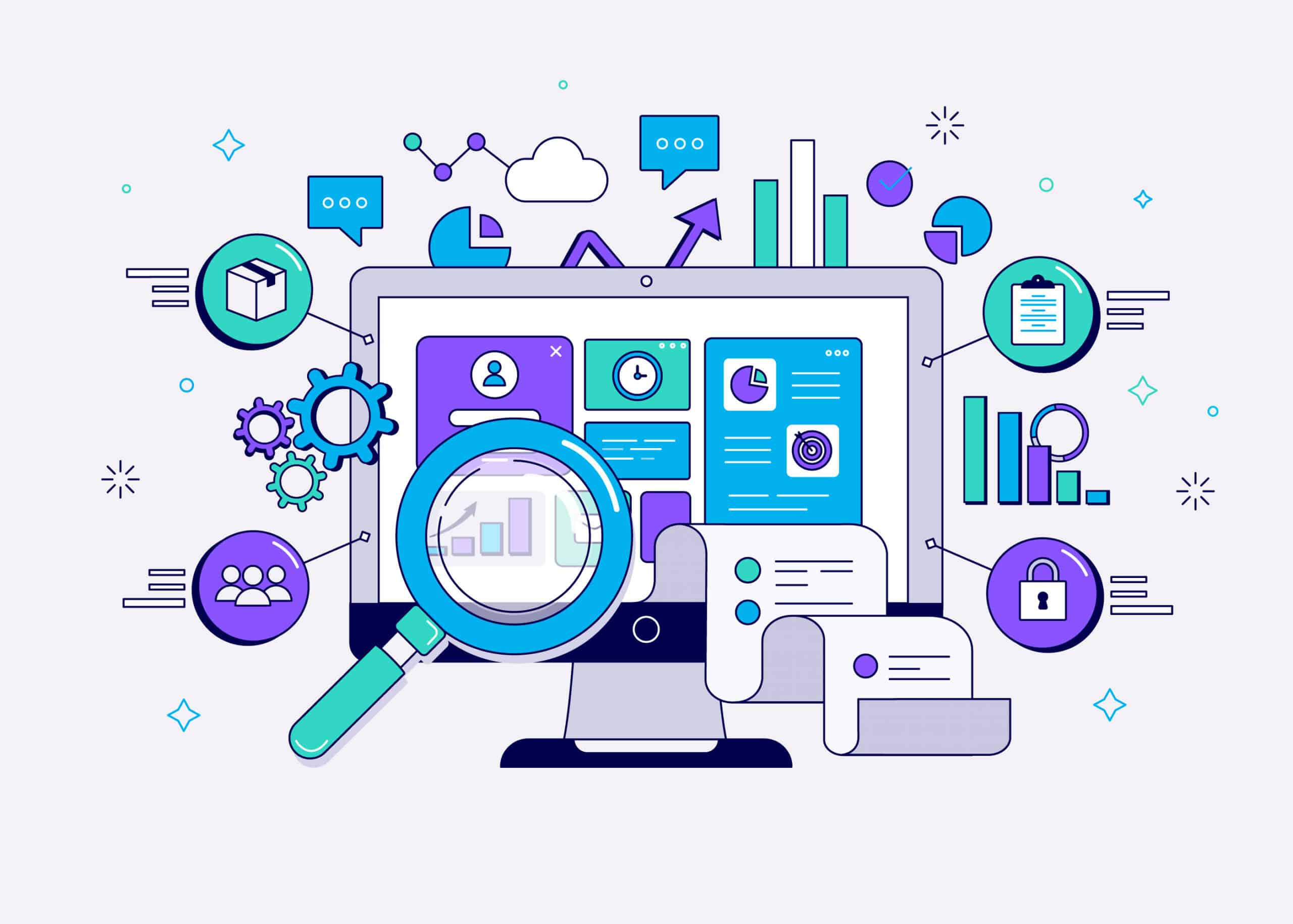
In a world dominated by data, business and technology leaders are increasingly looking to the power of predictive analytics because even though we have endless supplies of data, getting actionable information from that data is getting more and more difficult. The larger the amount of data, the more challenging it is to gain information from that data.
We are drowning in data.
Predictive analytics, powered by Artificial Intelligence (AI), has emerged as a powerful tool that can give your business a significant edge and help business leaders dig through those seas of data.
What Will You Get From This Article?
We’ll explore the world of and gaining an understanding of predictive analytics, demystify its connection with artificial intelligence, and educate you on what predictive analytics can offer.
What Exactly is Predictive Data Analytics?
There are four classes of data analytics:
- 📝 Descriptive, which answers the question, “What happened?”
- 🔍 Diagnostic, which answers the question, “Why did this happen?”
- 🔊 Prescriptive, which answers the question, “What should we do next?”
- 🌐 Predictive, which answers the question, “What might happen in the future?
Predictive analytics is the use of data to predict future trends and events. It uses historical data to forecast potential scenarios to help drive strategic decisions.
The ability to predict future events and trends is crucial across industries. Predictive analytics appears more often than you might assume—from your weekly weather forecast to algorithm-enabled medical advancements.
Catherine Coate – Harvard Business School Online
Understanding Predictive Analytics
Prediction is what we do when there’s no obvious answer. Historically, statistics have played an important role in predicting the future. For example, football coaches use a process called “win probability” to determine whether a team has a good or bad chance to win. During the movie “Moneyball,” GM Peter Brand (Tony Goldwyn) relied on statistics and data to build his team’s roster. In today’s world, though, we have access to more information about more things. Unfortunately, this abundance can create confusion and, even worse, misinformation.
Predictive analytics is the art of accurately using historical and real-time data to forecast future events or trends more accurately. Think of it as a crystal ball for businesses, but instead of magic, it relies on data and AI to make educated predictions.
The Synergy Between Predictive Analytics and Artificial Intelligence
AI plays a pivotal role in predictive analytics. Just like the human brain learns from experience, AI algorithms learn from data.
They analyze vast datasets to identify patterns, relationships, and anomalies that may escape the human eye. The combination of predictive analytics and AI can extract valuable insights from complex data, making it a strategic asset for your business.
Benefits of Predictive Analytics
Predictive analytics has a wide range of applications across various industries. It can help predict customer preferences, identify potential equipment failures, optimize supply chain management, and much more. The possibilities are endless.
🧑 Transforming Your Business Operations
Imagine having the ability to predict when your equipment is likely to fail. With predictive analytics, you can schedule maintenance just in time, preventing costly breakdowns and ensuring the smooth operation of your business.
😊 Enhancing Customer Experience
Predictive analytics can help you understand your customers on a profound level. By analyzing their past behaviour, you can tailor your products and services to meet their needs, increasing customer satisfaction and loyalty.
💵 Optimizing Sales and Marketing Strategies
Predictive Analytics is your secret weapon in the highly competitive world of sales and marketing. By predicting market trends and customer behaviour, you can fine-tune your strategies, ensuring every marketing dollar is well spent.
🧹 Predictive Maintenance for Efficiency
If your business relies on machinery, predictive maintenance is a game-changer. Instead of following a rigid maintenance schedule, you can use predictive analytics to detect potential issues in real-time, reducing downtime and saving costs.
Implementing Predictive Analytics Solutions
The addition of predictive analytics into your existing software solution represents a strategic endeavour that can empower your application to make data-driven forecasts and intelligent decisions. This requires business and technical engineering to make it all come together properly.
🗺️ Define Clear Objectives and Use Cases
Implementing predictive analytics begins with a clear definition of objectives and the identification of relevant use cases. What business problems or opportunities do you intend to address with predictive analytics? Whether it’s demand forecasting, anomaly detection, customer segmentation, or any other predictive task, a precise definition is imperative to ensure alignment with your software’s purpose.
🗃️ Big Data Collection and Preparation
Effective predictive analytics hinges on the quality and relevance of data. A robust data collection process must encompass gathering, cleaning, and preprocessing. Data sources must be identified and consolidated, and the data should be cleansed, transformed, and ready for analysis.
🧑🍳 Algorithm Selection
Different algorithms cater to different prediction challenges, such as regression, classification, time series analysis, and clustering. The selection process necessitates an evaluation of various algorithms based on factors like accuracy, interpretability, and resource requirements.
Metric Evaluation A metric is a quantitative measure of the correctness of the output based on the right mathematical models. Selection of the ideal number of features and tuning of the optimizer is critical for the success of the algorithm. Algorithms for Prediction Prediction problems can be generalized in many different ways. The problem of speech recognition is an example of a simple prediction problem; others include multiclass classification, regression, time series prediction, and clustering. The
🏃 Model Training and Validation
The core of predictive analytics implementation involves training and validating predictive models. This requires splitting data into training and testing sets, allowing the model to learn from the training data, and then evaluating its performance on the testing data. The process may involve hyperparameter tuning, cross-validation, and relevant evaluation metrics.
⚒️ Technical Software Integration
Seamless integration of predictive analytics models with your software solution is vital. This entails writing code to connect the predictive analytics module with the software’s front-end and back-end systems. Ensuring that the components can efficiently transmit data to the predictive model and interpret the model’s predictions is a technical challenge that warrants meticulous attention.
📈 Scalability and Performance Optimization
As your software solution scales and encounters larger volumes of data, scalability and performance optimization become paramount. The predictive analytics component must be capable of handling increased workloads. This could necessitate distributed computing, optimized algorithms, or utilization of cloud resources. Consistent performance monitoring and fine-tuning are essential to ensure software efficiency.
🖥️ User Interface and User Experience
User interface design plays a pivotal role in the successful implementation of predictive analytics. The user interface should be intuitive and responsive, seamlessly integrating predictive insights into the software’s user experience. Users should be able to interact with and benefit from the predictions with ease.
🔐 Security and Privacy
Security and privacy are non-negotiable aspects of predictive analytics implementation. Ensuring the security of predictive models, data, and user information is paramount. Robust authentication, authorization mechanisms, encryption, and secure data transmission protocols are prerequisites. Compliance with data privacy regulations, such as GDPR, must be an integral part of the implementation.
🧹 Maintenance and Continuous Improvement
Predictive models are dynamic and necessitate ongoing maintenance and refinement. Data patterns change, and new challenges emerge. Continuous retraining and updating of the predictive model are imperative. User feedback and real-world performance data should guide model enhancements and issue resolution.
Overcoming the Complexity of Predicitive Analytics Implementation
While predictive analytics holds immense potential, it has its challenges. Data quality, privacy concerns, and the need for skilled personnel are common hurdles businesses must address. However, with the right strategy, these challenges can be surmounted.
Implementing Predictive Analytics in Your Business
The implementation of predictive analytics requires careful planning. You need to define clear goals, gather relevant data, select the right tools, and develop a team capable of utilizing them effectively. It’s a step-by-step process that, when executed correctly, can lead to transformative results.
Measuring Success with Predictive Analytics
The success of predictive analytics can be measured in various ways, such as increased revenue, improved customer satisfaction, reduced costs, and more informed decision-making. Metrics and KPIs will help you track progress and make necessary adjustments.
Foresight is often the difference between thriving and struggling in the business world. Predictive analytics, powered by AI, is a key to unlocking that foresight.
Mantrax – Your Partner in Developing Predictive Analytics Solutions
Predictive Analytics enables your organization to make informed decisions, anticipate market trends, and accurately meet customer demands. As you embark on this journey, remember that challenges will arise, but with the right strategy, the benefits far outweigh the obstacles. If you want to get started on a Software Solution or get more information, Book a Discovery Call with Mantrax today to learn more about what we can do to elevate your business.
Predictive Analytics Development Resources
Unraveling the Power of Predictive Analytics by Ravel Kumar @ Dev.to
Predictive Analytics Resources via Github
5 Examples of Predictive Analytics via Harvard Business Review

